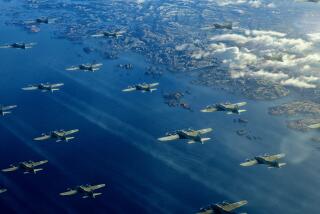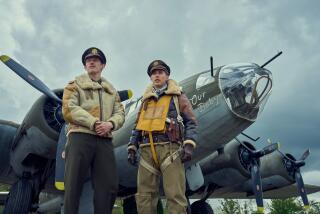Flights of Fancy : Model Airplanes Honor Black Pilots That History Forgot
After a hard day in the dental lab, Clint Martin unwinds at his Inglewood home by building model airplanes and embarking on flights of fancy.
He imagines what it would be like to fly a P-47 Thunderbolt. He remembers other World War II fighter planes on training missions, roaring over the small Mississippi town where he spent his childhood.
His dreams then were to follow in the footsteps of two black pilots from his McComb, Miss., neighborhood who were part of the Tuskegee Airmen, an all-black World War II squadron. The success of these pilots, who never lost a bomber to enemy aircraft, vindicated the employment of black military aviators.
As it turned out, Martin never became a pilot because of a hearing problem; he served four years in the Air Force as an enlisted man. But to commemorate the Tuskegee group’s achievements, he has spent thousands of hours painstakingly creating authentic models of the planes they flew, such as the P-47 Thunderbolt.
His models have been displayed at historical museums and Air Force bases across the country.
In January, Martin persuaded the Testor Corp., an Illinois manufacturer of plastic models, to market a kit of a P-47 Thunderbolt that contains the Tuskegee unit’s signature markings. Officials of the firm said the model is believed to be the first in the hobby market to honor the black airmen.
Because the unit’s aircraft markings included red tail sections, the Tuskegee fliers were dubbed the “Red Tails.” Almost 1,000 African-American pilots graduated from the Tuskegee, Ala., Air Corps Flying School, where they first trained. About 450 of them went on to fly in combat in North Africa and Europe. Yet, the airmen say, it wasn’t until recent years that their exploits were widely recognized.
“Why are there never any blacks in war movies? I think it is a part of history that America refused to tell,” said Martin, who works at the Veterans Administration Medical Center on the Westside. “Considering the era in which it took place, with racial discrimination at its staunchest, we have been led to believe that blacks never contributed (to the war), and that isn’t so.”
Martin, 53, has dedicated himself to ensuring that the black pilots are remembered.
“We have to tell people what has gone on,” Martin said. “We cannot rely on somebody else telling the story as it is supposed to be.”
Martin decided to tell the Tuskegee story by building model airplanes. His hobby turned serious in 1979, when he became fully aware of the Tuskegee Airmen through a news account. He spent seven years building five planes that now are on display at Tuskegee University in Alabama.
Each of the planes has tiny working flaps, retractable landing gear and movable canopies. More than 600 parts were required for each plane’s assembly, a challenge to the precise craftsmanship that goes with being a dental lab technician.
“My total intent when I started to build these airplanes,” Martin said, “was just to show them to the guys that built them, to take to air shows or whatever.”
And, in fact, the models are often displayed at air shows as well as hobby shops.
In addition, dozens of model kits are stacked in his den. Model planes rest in formation on metal shelves in his home. His den is ringed with framed pictures of Martin, in authentic flight gear, posed alongside vintage World War II aircraft.
With the patience of a Swiss watchmaker, he has carefully built replicas of planes such as the P-40 Warhawk, the B-25 Mitchell bomber, P-47 Thunderbolt and P-51 Mustang--all of which were at one time flown by the Tuskegee Airmen. Because model kits in hobby stores did not contain the Tuskegee unit’s authentic markings, Martin constructed his own, based on historical photos and interviews with surviving Tuskegee fliers.
The airmen have been pleased with the results.
“They’re very authentic,” said O. Oliver Goodall, who flew with the 477th Bombardment Group. Goodall, a retired postal worker, is public information officer for the Los Angeles chapter of Tuskegee Airmen Inc., a nonprofit organization of former pilots and supporters.
“(Martin) tries to ask each pilot what his plane’s markings are and tries to duplicate it, right down to details,” Goodall said. “We applaud him. We applaud all his efforts to really promote and authenticate our movement.”
More to Read
Sign up for The Wild
We’ll help you find the best places to hike, bike and run, as well as the perfect silent spots for meditation and yoga.
You may occasionally receive promotional content from the Los Angeles Times.






